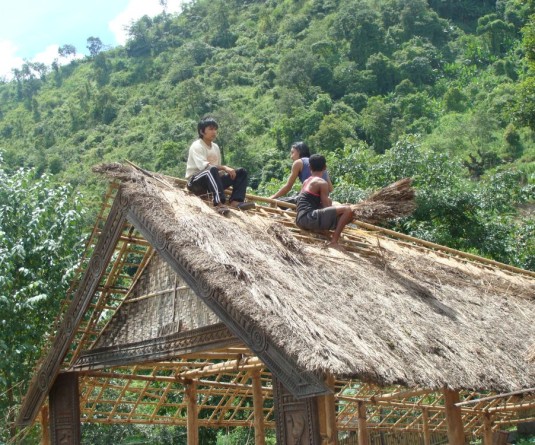A herd of wild elephants filmed by a villager.

Morung Express News
Beisumpuikam | July 19
Farmers in villages under Dhansiripar sub-division and adjoining Beisumpuikam village under Peren district are facing significant challenges as elephants increasingly venture into their plantations and fields, causing extensive damage to crops. These visits have become more frequent, leading to substantial economic losses to the villagers.
This situation is seen as a classic case of human-animal conflict, where expanding human settlements and agricultural activities intersect with the natural habitats of wildlife. This not only leads to the destruction of crops and property but also poses significant risks to both human and animal lives.
One affected farmer, Changduing Daime from Beisumpuikam, told The Morung Express that his banana and papaya crops which he planted in hisareca nut farmwere recently damaged by the elephants.

The young farmer said he earns between 5000-10,000 per month from his plantation of banana and papaya during seasons which he sells in Dimapur, Kohima and Senapati in Manipur.
Changduing said this has been a major setback to his livelihood, while revealing that at least 20-30 percent of his plantation have so far been damaged by elephants. “The frequency of elephants venturing into our area of cultivation is also increasing which is concerning,” he further stated.
Expressing concern over the situation, BeisumpuikamVillage Council Chairman, Tadi Zeliang noted that the elephants are now entering the village jurisdiction almost daily, sometime even venturing into the village itself.
“This frequent intrusion had made it increasingly difficult for villagers, especially children and farmers, to venture into the forest or their fields,” he highlighted.
“Those searching for animal fodder are particularly at risk, as elephants tend to frequent areas with lush vegetation. However, as farmers, we have no choice as we have to tend to our fields and plantation every day,” he lamented.
In response to elephant sightings, villagers are usually alerted through a public address system. Despite these precautions, the frequency of elephant’sincursionshas been rising year by year, Zeliang said.

The council chairman also highlighted the unique challenges of dealing with elephants compared to other animals, emphasizing the difficulty and danger involved in managing these encounters. A member of the village council mentioned that the forest department intervenes by attempting to chase the elephants away, but their efforts can only do so much.
This year, a lone elephant has been observed to be the culprit behind the damage to the crops, Beisumpuikam farmers, meanwhile, reported.
“We need a more effective measure to address the growing issue, as the persistent presence of elephants continues to threaten our safety and livelihood,” they voiced out.
The neighbouring village of Manglumukh, located just before reaching Beisumpuikam, is facing similar situation. Farmers have reported frequent elephant intrusion, resulting substantial crop damage.
According to Bejon, a farmer from Manglumukh, large expanse of banana plantations belonging to four families were damaged recently by the visiting elephants. Other than that, numerous areca nut, paddy, cabbage, pumpkin and watermelon fields were also destroyed, he stated.
“Villagers do not report all incidents of elephant damage to the concerned department because no action is taken,” Bejon stated.
Manglumukh Village Council Chairman,Udil Haflongfar told The Morung Express that they had received reports of a herd of elephants spotted at Doyapur village area and moving towards Dhansirireserve forests in Assam where they usually originate from.
He expressed deep concern over the situation, noting that incidents of elephants raiding crops have become alarmingly common. In 2023, a woman from Manglumukh narrowly escaped death when she encountered an elephant on her way to the field. The sudden encounter left both the woman and the elephant startled that in their frantic attempts to escape, no harm came to her.
A recent human and wildlife conflict survey carried out by the Wildlife Conservation Society of India (WCS-I), on elephant intrusion in the last five years, revealed that48.8 percent from Beisumpuikam village reported elephant damage to crops.
This data was revealed by Sourav Dutta, Project Coordinator for Nagaland Conservation and Livelihood Project under WCS-I also revealed that in Manglumukh village, almost all household from the village reported of crop damage by elephants.
WCS-I is currently implementing the Integrated Tiger Habitat Conservation Programme, Phase-2 at six villages in the fringes of Ntangki National Park.In all of these villages, the engagement is with the communities, with special focus on the youth and the women to provide sustainable alternate livelihood.
In Doyapur village area, under Dhansiripar sub-division, a herd of elephants was reported to have stayed overnight a week ago, during which a large number of crops in fields and plantation were destroyed.
A video clip shared by a farmer shows a herd of five elephants moving calmly through afield. The aftermath of their visit, as shown in other video clips and images, reveals destroyed paddy fields and plantations.
Conservationists and affected farmers have observed that the elephants causing havoc in Beisumpuikam and surrounding villages in Dhansiripar sub-division in Dimapur district originate from the Dhansiri Reserve Forests. These elephants cross the Dhansiri River, moving towards Nagaland in search of fodder.
Their migration pattern has been a part of their natural behaviours for ages, as the area is regarded as a traditional elephant corridor.






